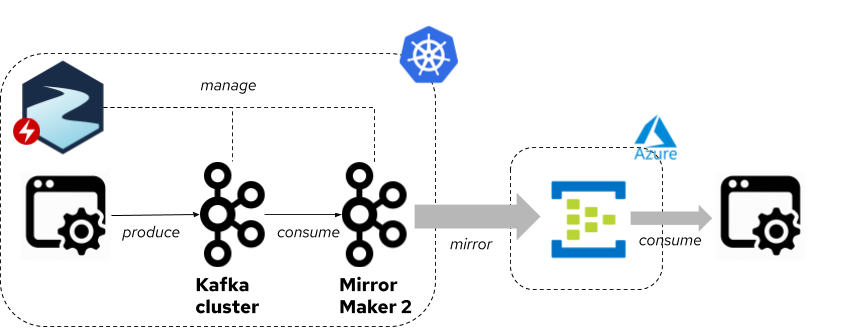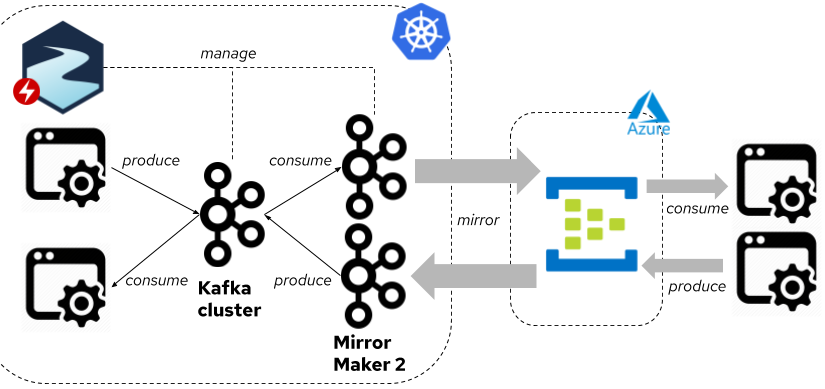In the previous blog post we talked about mirroring data from an Apache Kafka cluster running on Kubernetes to Azure Event Hub, using the first version of Mirror Maker. With Apache Kafka 2.4.0, Mirror Maker 2 was released in order to overcome the limitations of Mirror Maker and adding more powerful features. This blog post is a continuation of the previous one and it’s going to show how to use the Strimzi cluster operator to configure and deploy Kafka Mirror Maker 2 in order to mirror topics to Azure Event Hub. It’s not going to show everything from scratch but we assume that your Kafka cluster is already running and you have already created an Azure Event Hub namespace. If you want to know more about Mirror Maker 2 and its integration with Strimzi, you can read this blog post. The source code is available at this repo.
Prerequisites
Let’s assume that your Apache Kafka cluster is already running on Kubernetes, in the kafka namespace, and you already have created the corresponding Azure Event Hub namespace.
The overall architecture with a Kafka producer and a consumer on both sides looks like the following.

The topic we want to mirror data from is described trough the following KafkaTopic resource and it’s named testeh.
apiVersion: kafka.strimzi.io/v1beta1
kind: KafkaTopic
metadata:
name: testeh
labels:
strimzi.io/cluster: my-cluster
spec:
partitions: 1
replicas: 1
config:
retention.ms: 7200000
segment.bytes: 1073741824
Save it in the kafka-topic.yaml file and create the topic on the Kubernetes cluster.
kubectl apply -f kafka-topic.yaml -n kafka
The Strimzi topic operator takes care of this custom resource, creating the topic in the Apache Kafka cluster.
For authenticating to the Azure Event Hub namespace, the following snippet shows the endpoint that has to be customized with the actual Event Hub connection string; save this Secret in a file named eventhubs-secret.yaml
apiVersion: v1
kind: Secret
metadata:
name: eventhubssecret
type: Opaque
stringData:
eventhubspassword: Endpoint=sb://<eventhubs-namespace>.servicebus.windows.net/;SharedAccessKeyName=RootManageSharedAccessKey;SharedAccessKey=<access-key>
Create the Secret on the Kubernetes cluster.
kubectl apply -f eventhubs-secret.yaml -n kafka
Configure Kafka Mirror Maker 2
The Kafka Mirror Maker 2 instance is deployed via the Strimzi cluster operator through a corresponding KafkaMirrorMaker2 resource as the following.
apiVersion: kafka.strimzi.io/v1alpha1
kind: KafkaMirrorMaker2
metadata:
name: my-mm2-cluster-to-eh
spec:
version: 2.5.0
replicas: 1
connectCluster: "eventhub"
clusters:
- alias: "my-cluster"
bootstrapServers: my-cluster-kafka-bootstrap:9092
- alias: "eventhub"
bootstrapServers: <eventhubs-namespace>.servicebus.windows.net:9093
config:
config.storage.replication.factor: 1
offset.storage.replication.factor: 1
status.storage.replication.factor: 1
producer.connections.max.idle.ms: 180000
producer.metadata.max.age.ms: 180000
authentication:
type: plain
username: $ConnectionString
passwordSecret:
secretName: eventhubssecret
password: eventhubspassword
tls:
trustedCertificates: []
mirrors:
- sourceCluster: "my-cluster"
targetCluster: "eventhub"
sourceConnector:
config:
replication.factor: 1
offset-syncs.topic.replication.factor: 1
sync.topic.acls.enabled: "false"
heartbeatConnector:
config:
heartbeats.topic.replication.factor: 1
checkpointConnector:
config:
checkpoints.topic.replication.factor: 1
topicsPattern: ".*"
groupsPattern: ".*"
It has to connect to the clusters through the related bootstrapServers connections that are described in the clusters section.
The first one, “my-cluster” is the Apache Kafka cluster running on Kubernetes; the other one, “eventhub” is the Azure Event Hub namespace.
In this example, there is no need for a special configuration for the local source cluster but we need more for the Azure Event Hub.
The connection to the Event Hub namespace is based on TLS and PLAIN authentication using $ConnectionString as username and the connection string as password provided in the already created eventhubssecret.
The tls section is configured as Event Hub needs SSL with SASL_SSL as security protocol
While working with this configuration, I noticed that after a period of inactivity, so not sending messages as a steady stream, the mirroring suddenly stopped after a few minutes.
It turns out that it’s really important to set the configuration of connections.max.idle.ms and metadata.max.age.ms, for the producer, with a value less than 4 minutes!
You could ask … from where does this “magic” value come ?
This is related to the behaviour of the Azure load balancers, in front of the Event Hub, which have an idle timeout setting of 4 minutes to 30 minutes.
By default, it is set to 4 minutes.
If a period of inactivity is longer than the timeout value, there’s no guarantee that the TCP ession is maintained between the client and the cloud service.
You can find more information on the official Microsoft documentation.
The recommended configuration parameters for connecting to Azure Event Hub are also described here.
The mirrors section describes what has to be mirrored and what should be the flow.
In this case, the local “my-cluster” is the source and the “eventhub” is the target.
Kafka Mirror Maker 2 is based on Kafka Connect and it uses a bunch of connectors for doing the mirroring, the heartbeating and the checkpointing.
The sourceConnector is a specific Kafka Connect connector actually doing the mirroring, so reading from the local source cluster and making the messages available to Kafka Connect in order to mirror them to Azure Event Hub.
The heartbeatConnector periodically checks connectivity between clusters.
The checkpointConnector tracks and maps offsets for specified consumer groups using an offset sync topic and checkpoint topic.
Create the KafkaMirrorMaker2 on the Kubernetes cluster saving the above resource into a kafka-mirror-maker-2-to-eh.yaml file.
The Strimzi cluster operator takes care of it, deploying Kafka Mirror Maker 2 using the above configuration.
kubectl apply -f kafka-mirror-maker-2-to-eh.yaml -n kafka
Produce, mirror and consume!
For the purpose of this demo, the application consuming the mirrored messages from Azure Event Hub is the kafka-console-consumer command line tool, provided with Apache Kafka, which needs a proper configuration as described below.
bootstrap.servers=<eventhubs-namespace>.servicebus.windows.net:9093
security.protocol=SASL_SSL
sasl.mechanism=PLAIN
sasl.jaas.config=org.apache.kafka.common.security.plain.PlainLoginModule required username="$ConnectionString" password="Endpoint=sb://<eventhubs-namespace>.servicebus.windows.net/;SharedAccessKeyName=RootManageSharedAccessKey;SharedAccessKey=<access-key>";
connections.max.idle.ms=180000
metadata.max.age.ms=180000
Save the above properties into a kafka_eventhub.properties file and start the consumer as following.
bin/kafka-console-consumer.sh --bootstrap-server <eventhubs-namespace>.servicebus.windows.net:9093 --topic my-cluster.testeh --consumer.config kafka_eventhub.properties
To try the demo, the only thing left to do is to send some messages.
To do so, just use the kafka-console-producer command line tool provided with Apache Kafka.
Start a new pod in the Kubernetes cluster for hosting the producer and type a couple of messages as follows.
kubectl -n kafka run kafka-producer -ti --image=strimzi/kafka:0.18.0-kafka-2.5.0 --rm=true --restart=Never -- bin/kafka-console-producer.sh --broker-list my-cluster-kafka-bootstrap:9092 --topic testeh
If you don't see a command prompt, try pressing enter.
>"Hello from Strimzi Mirror Maker 2"
>"Here another mirrored message"
>
On the Kafka console consumer application, the messages will be logged like this:
"Hello from Strimzi Mirror Maker 2"
"Here another mirrored message"
Let’s go “active-active”
There are some scenarios where it’s needed having a bidirectional mirroring in order to have producer and consumer on both sides, consuming data on the “same” topic.

In the previous unidirectional use case, the producer writes to the testeh topic on the local Kafka cluster and it’s mirrored to the my-cluster.testeh on Azure Event Hub from where the consumer gets messages.
If we want to produce messages to a testeh event hub on Azure Event Hub namespace and mirroring this one to the local Kafka cluster, we have to setup another KafkaMirrorMaker2 instance where source and target are switched.
In this case the destination topic on the local Kafka cluster will be eventhub.testeh.
apiVersion: kafka.strimzi.io/v1alpha1
kind: KafkaMirrorMaker2
metadata:
name: my-mm2-cluster-from-eh
spec:
version: 2.5.0
replicas: 1
connectCluster: "my-cluster"
clusters:
- alias: "my-cluster"
bootstrapServers: my-cluster-kafka-bootstrap:9092
- alias: "eventhub"
bootstrapServers: <eventhubs-namespace>.servicebus.windows.net:9093
config:
config.storage.replication.factor: 1
offset.storage.replication.factor: 1
status.storage.replication.factor: 1
consumer.connections.max.idle.ms: 180000
consumer.metadata.max.age.ms: 180000
authentication:
type: plain
username: $ConnectionString
passwordSecret:
secretName: eventhubssecret
password: eventhubspassword
tls:
trustedCertificates: []
mirrors:
- sourceCluster: "eventhub"
targetCluster: "my-cluster"
sourceConnector:
config:
replication.factor: 1
offset-syncs.topic.replication.factor: 1
sync.topic.acls.enabled: "false"
heartbeatConnector:
config:
heartbeats.topic.replication.factor: 1
checkpointConnector:
config:
checkpoints.topic.replication.factor: 1
topicsPattern: ".*"
groupsPattern: ".*"
Create the KafkaMirrorMaker2 on the Kubernetes cluster saving the above resource into a kafka-mirror-maker-2-from-eh.yaml file.
The Strimzi cluster operator takes care of it deploying Kafka Mirror Maker 2 using the above configuration.
kubectl apply -f kafka-mirror-maker-2-from-eh.yaml -n kafka
In this way, we can add another producer on the Event Hub side sending messages to the testeh event hub.
We can use the kafka-console-producer for this purpose.
bin/kafka-console-producer.sh --bootstrap-server functiontesteh.servicebus.windows.net:9093 --topic testeh --producer.config kafka_eventhub.properties
If you don't see a command prompt, try pressing enter.
> "Hello from Strimzi Mirror Maker 2 sent to testeh Event Hub
>
The producer is in addition to the one we used in the previous paragraph which is producing locally to testeh in the Kafka cluster.
kubectl -n kafka run kafka-producer -ti --image=strimzi/kafka:0.18.0-kafka-2.5.0 --rm=true --restart=Never -- bin/kafka-console-producer.sh --broker-list my-cluster-kafka-bootstrap:9092 --topic testeh
If you don't see a command prompt, try pressing enter.
>"Hello from Strimzi Mirror Maker 2 sent to testeh Kafka"
>
We can also add a consumer on the local Kafka cluster getting messages on the corresponding mirrored eventhub.testeh topic.
kubectl -n kafka run kafka-consumer -ti --image=strimzi/kafka:0.18.0-kafka-2.5.0 --rm=true --restart=Never -- bin/kafka-console-consumer.sh --bootstrap-server my-cluster-kafka-bootstrap:9092 --whitelist .*testeh
"Hello from Strimzi Mirror Maker 2 sent to testeh Event Hub"
"Hello from Strimzi Mirror Maker 2 sent to testeh Kafka"
The consumer used in the previous paragrah will get both the messages as well.
bin/kafka-console-consumer.sh --bootstrap-server <eventhubs-namespace>.servicebus.windows.net:9093 --whitelist .*testeh --consumer.config kafka_eventhub.properties
"Hello from Strimzi Mirror Maker 2 sent to testeh Event Hub"
"Hello from Strimzi Mirror Maker 2 sent to testeh Kafka"
As you could have noticed, both the consumers have to subscribe to a topic pattern like .*testeh so that the one running locally can get messages from the local testeh and the mirrored eventhub.testeh; the other one connected to Azure Event Hub can get messages from the testeh event hub and the mirrored my-cluster.testeh.
Conclusion
Kafka Mirror Makers 2 overcomes the limitations of Mirror Maker and it allows to setup more complicated use cases like an active-active mirroring. Thanks to its integration in Strimzi, it’s even simpler to setup this kind of scenarios with Azure Event Hub as well.
Let us know what you are going to integrate!
